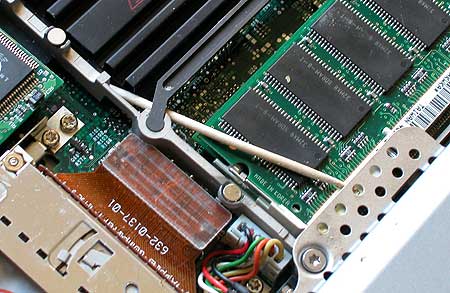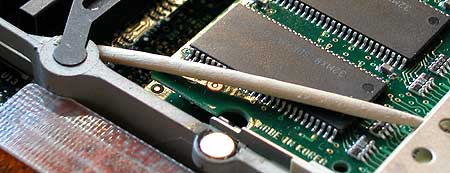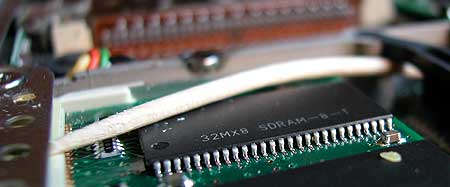Repairing the PowerBook’s RAM slot with a toothpick
Posted by Pierre Igot in: MacintoshJune 16th, 2006 • 5:20 pm
If you’ve read this blog in the past couple of weeks, you know that we bought a brand new MacBook to replace my wife’s five-year-old Titanium PowerBook G4—only to return it to Apple within a few days because of a horrible mooing noise that Apple insists is “normal” and “within spec,” even though we found it impossible to live with it.
So my wife had to go back to her trusty old PowerBook G4. This machine has given us few problems over the years (apart from its abysmal AirPort range, which was a problem from the very beginning and is clearly a design flaw with this generation of machines). In more recent times, however, it has started to show its age not just in its poor performance with more recent software titles, but also in its physical structure.
The main problems have been with the keyboard—which was a bit flimsy from the very beginning: I, with my big hands, would easily get the tip of my fingers caught underneath the edge of the key, which would cause the keys to snap off. They had to be snapped back on each and every time. However, my wife’s hands are significantly smaller, and she never really had much of a problem with it.
Recently, however, we discovered that the “8” key had become more fragile and would snap off even when my wife was typing. A closer inspection revealed that one of the two slots which the underside of the key snaps on was broken. The key still holds thanks to the other slot on the other side, but obviously it snaps off much easier.
Then the space bar stopped working altogether. Again, closer inspection revealed some wear and tear that prevented the springing mechanism from springing back properly. That was a bit more problematic, as the space bar is, well, essential, and the problem was not just an intermittent one like the one with the “8” key. Fortunately, I was able to pad the underside of the space bar itself with a few layers of masking tape, and that added just enough thickness to enable the springing mechanism to work again.
But that was pretty much it, as far as physical problems with the machine were concerned—until last week, that is.
Just after we returned the MacBook to Apple and I transferred all of my wife’s stuff back on the TiBook, as if on cue, a more serious problem surfaced. One morning, my wife called me to tell me that the keyboard had a weird bulge in the middle of it. I took a look, and indeed the keyboard was no longer flat. I snapped it open and discovered the source of the problem right away: the RAM module in the top RAM slot, which is located right underneath the keyboard, was sticking out.
Fortunately enough, the RAM module hadn’t completely come out of the slot, and obviously there was still enough contact for it to continue to work properly (Mac OS X appeared unaffected and was still running properly).
I immediately turned the machine off and then tried to push the RAM module back into its slot, so that it would be flat and not stick out anymore. But it wouldn’t stay in place. Again, closer inspection revealed that something was indeed broken.
The RAM module is normally held in place by two D-shaped plastic tabs sticking out from each side. When you push the RAM module down, it pushes these tabs, which are part of a flexible piece of plastic moulding, and once the edges of the RAM module are underneath the tabs, the tension in the plastic moulding causes the tabs to move back over the RAM module and hold it in place. (If you want to remove the RAM module, you normally have to push these two D-shaped tabs with your fingers, and the upwards tension causes the RAM module to stick out naturally when it’s no longer held in place by the tabs.)
Obviously, after all these years, the plastic on one side had dried up and cracked, and the D-shaped tab was gone, along with a good chunk of the rest of the plastic structure. This meant that there was no longer anything to hold the RAM module in place on one side. And there was nothing that I could do to repair that piece of plastic.
This looked like a pretty serious problem, especially since the PowerBook badly needs the extra RAM in order to be able to run Mac OS X properly. (Even with the extra RAM, it still only has a total of 384 MB, which is not that great when running Tiger.) However, I figured that there had to be other ways to hold the RAM module in place. As long as I could get something both rigid and flexible enough and also long enough to fit under two solid parts on either side of the RAM module, I should be able to keep the RAM module flat.
That something both rigid and flexible enough and also long enough turned out to be… a toothpick. I just got one from the kitchen and tried to make it fit, and… it worked perfectly!
Here’s what the repair looks like, from three different angles:



Pretty nifty, if I may say so myself!
The toothpick appears to be strong enough. It won’t break any time soon, and there’s nothing that will cause it to move. And it is bent, but not enough to cause the keyboard above it to bulge or anything. In other words, it’s perfect!
And it took me the whole of five minutes.
I am guessing we might not be the only ones with RAM slot plastic mouldings that dry up and crack after five years, so maybe this post and these pictures will be helpful to someone else!
At least, it means that we don’t have to buy a new computer right away. Because there is just no way that I am buying a mooing laptop again, and, as far as I can tell, both MacBooks and MacBook Pros can be affected by the mooing. So we are definitely going to be waiting a while until Apple sorts this out—and hope that the TiBook lasts long enough.